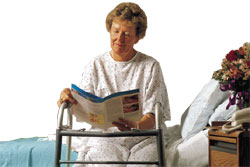Introduction
- Counselling patients
- Decision making
- Ensuring realistic expectations
- Consent
- Planning the operation
- Surgical intervention
- Post-operative recovery
Introduction
Plastic surgery involves not just a single operation, but also numerous consultations with medical professionals to make decisions about and plan the surgery. Plastic surgery procedures carry many health risks, and can alter a person’s self-perception and self-esteem in both the short and the long term. Before undergoing plastic surgery, it is important to discuss the procedure with a plastic surgeon and other medical professionals, and obtain accurate and detailed information about the procedure being considered and the potential risks it involves. Without obtaining such information, an individual cannot give their informed consent to be operated upon, and thus plastic surgeons are legally obliged to provide patients with information.
Considering alternative treatments and psychosocial support
Whether reconstructive or cosmetic, many plastic surgery operations aim to change a person’s appearance. Regardless of the type of surgery, it is important to consider issues such as self-esteem and whether or not plastic surgery and changing appearance are the most appropriate treatments.
In the United Kingdom, 1.3 million people live with severe facial and body deformities, and there are many non-surgical interventions that health professionals can use to help them live with – rather than change – their appearance. For example, Changing Faces (http://www.changingfaces.org.uk), a support group for people with disfigurements, offers advice on how to improve communication and relax in social situations.
Psychosocial support is critical whether or not individuals decide to undergo plastic surgery. Individuals who receive this support tend to be more satisfied with the outcomes of their surgery.
Decision making
Decision making should be carried out with the advice of a plastic surgeon. When consulting a plastic surgeon, it is important for individuals to talk frankly and openly about their goals and the changes they would like to see.
When considering plastic surgery, some people focus more on the expected result rather than the surgical procedure and the risks it involves. However, all plastic surgery procedures carry a risk. This is true whether the surgery is for reconstructive or cosmetic purposes, and whether it is carried out under general or local anaesthesia. It is therefore important to obtain comprehensive and accurate information about the risks involved in plastic surgery, both in the short and long term. The risks should be fully considered, as should personal expectations of the appearance change following the surgery, and whether or not these are realistic.
General practitioners will be able to help people considering plastic surgery by providing referrals to certified plastic surgeons. The Australian Society of Plastic Surgeons also provides an internet registry of certified practitioners, including their location and the types of procedures they perform, to help people choose an appropriate surgeon.
 |
For more information, see Choosing a Plastic Surgeon. |
Ensuring realistic expectations
Regardless of whether surgery is reconstructive or cosmetic, people considering surgery should discuss the likely outcomes with their surgeon to ensure that they have realistic expectations about how the procedure will affect them and their appearance.
It may be useful to ask the plastic surgeon:
- Are they a good candidate for surgery?
- What do they need to do before and after the surgery to get the best results?
- What type of reconstruction is recommended, including the size and shape of reconstructed body parts, where incisions will be made, and the expected texture of altered body parts?
- How long will recovery from the surgery take? Is bruising, swelling or bleeding to be expected after the surgery?
- What will they need to do while recovering to get the best results?
- Will they need assistance during the recovery period?
- What are the risks and potential complications associated with the surgical technique? Is any scarring likely to occur as a result of the procedure?
- How are complications handled?
- Will they need to take time off work to recover from the surgery?
- Is surgery aftercare included in the treatment costs?
- What options are available if they are unsatisfied with the results of the surgery?
- How much does the surgery cost? Will any of the costs be covered by Medicare or health insurance?
Consent

- The nature of the surgery;
- Indications for the procedure (when it is necessary for health reasons);
- Expected benefit;
- Potential risks, complications and side effects associated with the procedure, including their likelihood and severity;
- Alternative treatments to the procedure being considered, and the risks, complications and benefits associated with alternative treatments;
- Anticipated outcomes; and
- Cost of the procedure and related healthcare.
After receiving such information, all individuals who choose plastic surgery or their legal representatives (e.g. in the case of minors) must then sign a consent form before the operation. After receiving this information, signing the consent form and undergoing surgery should not be rushed. Time should be taken to thoroughly consider different options and weigh up the risks and benefits of plastic surgery. For example, a consideration period of at least 30 days is recommended for women undergoing breast augmentation (implant) procedures. Individuals should also obtain written information from their plastic surgeon, which they can read in their own time.
Obtaining objective information is not always straightforward, particularly as many of the risks of plastic surgery remain unknown. It is important that your plastic surgeon clearly distinguishes between unknown risk (when there is no scientific evidence and it is not yet known whether or not a particular risk is associated with a particular plastic surgery procedure) and no risk (when there is scientific evidence demonstrating that a plastic surgery procedure does not increase the risk of a particular condition).
It is also important to obtain information about the short and long term risks and ensure it is specific to the procedure being considered. For example, breast augmentation candidates may expect to receive the following information in a consultation about the surgery:
- Most breast implants need to be replaced at some point;
- Individuals who undergo the procedure are likely to require follow-up surgery at some point in the future:
- The likelihood of complications and unsatisfactory outcomes increases with repeat operations; and
- Follow-up operations are not usually covered by health insurance, even if the initial breast augmentation was medically indicated (e.g. following breast cancer).
Parental decision making and consent for children to undergo plastic surgery

In the latter case, parents may question whether or not it is best to have the child operated on, or wait until the child is old enough to decide for themselves. Factors that should be considered before deciding if plastic surgery is the best option include:
- The child’s adjustment to and satisfaction with their appearance;
- Their acceptance amongst peers (e.g. whether or not they are teased by their friends); and
- Their emotional health.
Parents should also consult a range of health professionals in addition to the plastic surgeon (e.g. a paediatrician) before deciding whether or not their child should undergo plastic surgery.
Planning the operation
The operation should be planned for a time when there is no significant stress in other areas of life (e.g. emotional upheavals such as the breakdown of a relationship). The surgery should also be planned so that it does not coincide with a period of intense physical activity.
Surgical intervention
The length of time required for plastic surgery depends largely on the type and complexity of the procedure to be undertaken. For some patients a single operation will be sufficient, while others may need multiple operations. Different procedures take different lengths of time. For example, ear surgery typically takes 2–3 hours, but may take longer for more complex operations.
All plastic surgery procedures involve some form of anaesthesia. The plastic surgeon will recommend the use of local or general anaesthetic, as appropriate for the type of procedure being undertaken. It is important to ensure that the anaesthetic is administered by a doctor who specialises in anaesthesia.

Other components of the surgery vary depending on the operative techniques employed.
Liposuction (also called lipoplasty) procedures require small incisions to be made into the targeted areas of the body. These areas are then infused with a sterile liquid that reduces the trauma and bleeding associated with the procedure. A hollow tube is then used to dislodge deposits of fat under the skin before the fat is aspirated from the body using a vacuum device. Lipoplasty can be used on many areas of the body, including the buttock, thighs, abdomen and face.
Augmentation procedures involve incisions through which implantable devices are inserted to increase the size of particular body characteristics. The most common augmentation is on the breasts. Breast augmentation may involve inframammary (at the base of the breast); transaxillary (under arm) or periareola (around the nipple) incisions, through which implants are inserted. The most appropriate incision depends on the individual’s anatomy and preference, as well as the degree of enlargement.
Lift and tuck procedures involve removing excess skin and tightening the remaining skin so that it fits smoothly over the underlying tissues. Lift and tuck procedures are sometimes combined with liposuction to remove fat from the body area being operated on.
Procedures to reshape the nose, chin, ears or other features involve incisions around the body feature to allow access to underlying bones and tissues. It is common for cartilage to be sculpted and removed to give a new shape. Skin is often removed to ensure that it remains tight.
Post-operative recovery

It is important to follow any advice given by the plastic surgeon to optimise recovery. In particular, make sure incision wounds are not subject to pressure or force. It may also be necessary to change bandages and dressings, and apply or take medication to help the wound-healing process.
Special garments may need to be worn. For example, people who have had lift, tuck and liposuction procedures may need to wear compression stockings to reduce swelling, while those who have undergone blepharoplasty (eyelid lift) will need to wear dark sunglasses in the post-operative period.
The plastic surgeon will provide specific instructions on how to care for the wounds following the operation.
The length of time it takes to recover from plastic surgery and the degree of dependence on the help of others after the operation varies, depending on the type of surgery and the individual.
People being treated on an out-patient basis will need to arrange someone to drive them home. Most people will require physical assistance from a carer for at least two days after surgery and often longer, particularly if they have responsibilities such as caring for children, or have undergone surgery which affected their muscles (e.g. abdominoplasty or tummy tuck).
Rigorous exercise and physical labour (including lifting more than 7 kg) is generally not recommended for two weeks after plastic surgery. Contact sports should not be played for at least a month.
Emotional support is important following the operation, and can help people adjust to their new image. In the weeks after the operation, the body part operated on usually remains bruised and swollen, and the individual’s image may cause them alarm. Because of a displeasing appearance, some people will not feel comfortable appearing in public for a week or more after surgery. This is particularly true for individuals who have undergone facial plastic surgery.
It is not uncommon to feel mildly unhappy after plastic surgery, and some people will become depressed because they do not achieve the image they had hoped for. This is particularly true for those undergoing multi-stage procedures (where the results are not yet finished after the initial recovery) and those with a history of depression. Depression usually lasts less than a week. Individuals who continue to feel depressed should seek medical advice.
References
- Wood SF, Spear SL. What do women need to know and when do they need to know it? Plast Reconstr Surg. 2007;120(7 Suppl 1):135-9S.
- Clarke A. Handling other people’s reactions: Communicating with confidence when you have a disfigurement [online]. London, UK: Changing Faces; 10 August 2007. [cited 10 May 2010]. Available from URL: http://admin.changingfaces.org.uk/ downloads/ Handling%20Reactions.pdf
- Psychological aspects: Your self-image and plastic surgery [online]. Arlington Heights, IL: American Society of Plastic Surgeons; 2008 [cited 5 May 2010]. Available from URL: http://www.plasticsurgery.org/ Patients_and_Consumers/ Planning_Your_Surgery/ Psychological_Aspects_Your_Self-Image_and_Plastic_Surgery.html
- What should you know abut the safety of outpatient surgery? [online]. Arlington Heights, IL: American Society of Plastic Surgeons; 24 June 2000 [cited 2 May 2010]. Available from URL: http://www.plasticsurgery.org/ Patients_and_Consumers/ Plastic_Surgery_FAQs/ What_should_you_know_about_the_safety_of_outpatient_surgery.html
- Australian Society of Plastic Surgeons [home page]. St Leonards, NSW: Australian Society of Plastic Surgeons; 2009 [cited 2 May 2010]. Available from URL: http://www.plasticsurgery.org.au/
- How to find a surgeon [online]. St Leonards, NSW: Australian Society of Plastic Surgeons; 2009 [cited 2 May 2010]. Available from URL: http://www.plasticsurgery.org.au/ Patients-and-Consumers/ How-to-find-a-surgeon/
- Reconstructive plastic surgery procedures at-a-glance [online]. Arlington Heights, IL: American Society of Plastic Surgeons; 2010 [cited 5 May 2010]. Available from URL: http://www.plasticsurgery.org/ Patients_and_Consumers/ Procedures/ Reconstructive_Procedures.html
- Planning your surgery [online]. St Leonards, NSW: Australian Society of Plastic Surgeons; 2009 [cited 2 May 2010]. Available from URL: http://www.plasticsurgery.org.au/ Patients-and-Consumers/ Planning-Your-Surgery/
- Statement of principle on informed consent [online]. St Leonards, NSW: Australian Society of Plastic Surgeons; 1 August 2008. [cited 10 May 2010]. Available from URL: http://www.plasticsurgery.org.au/ _framework/ modules/ repository/ DownloadFile.ashx?guid=E364B13F-6B04-437B-BC1F-EDDB7067C21E
- Therapeutic Goods Administration. Breast implant information booklet [online]. Woden, ACT: Australian Government Department of Health and Ageing; 2001 [cited 10 May 2010]. Available from URL: http://www.tga.gov.au/ docs/ pdf/ breasti4.pdf
- American Society of Plastic Surgeons. Ear surgery [online]. St Leonards, NSW: Australian Society of Plastic Surgeons; 2009 [cited 10 May 2010]. Available from URL: http://www.plasticsurgery.org.au/ default.aspx?itemid=173
- American Society of Plastic Surgeons. Arm lift [online]. St Leonards, NSW: Australian Society of Plastic Surgeons; 2009 [cited 10 May 2010]. Available from URL: http://www.plasticsurgery.org.au/ default.aspx?itemid=163
- American Society of Plastic Surgeons. Body contouring [online]. St Leonards, NSW: Australian Society of Plastic Surgeons; 2009 [cited 10 May 2010]. Available from URL: http://www.plasticsurgery.org.au/ default.aspx?itemid=164
- American Society of Plastic Surgeons. Liposuction [online]. St Leonards, NSW: Australian Society of Plastic Surgeons; 2009 [cited 10 May 2010]. Available from URL: http://www.plasticsurgery.org.au/ default.aspx?itemid=180
- American Society of Plastic Surgeons. Breast augmentation [online]. St Leonards, NSW: Australian Society of Plastic Surgeons; 2009 [cited 10 May 2010]. Available from URL: http://www.plasticsurgery.org.au/ default.aspx?itemid=167
- What is recovery from plastic surgery like? [online] Arlington Heights, IL: American Society of Plastic Surgeons; 2010 [cited 5 May 2010]. Available from URL: http://www.plasticsurgery.org/ Patients_and_Consumers/ Plastic_Surgery_FAQs/ What_is_recovery_from_plastic_surgery_like.html
- American Society of Plastic Surgeons. Eyelid surgery [online]. St Leonards, NSW: Australian Society of Plastic Surgeons; 2009 [cited 10 May 2010]. Available from URL: http://www.plasticsurgery.org.au/ default.aspx?itemid=174
All content and media on the HealthEngine Blog is created and published online for informational purposes only. It is not intended to be a substitute for professional medical advice and should not be relied on as health or personal advice. Always seek the guidance of your doctor or other qualified health professional with any questions you may have regarding your health or a medical condition. Never disregard the advice of a medical professional, or delay in seeking it because of something you have read on this Website. If you think you may have a medical emergency, call your doctor, go to the nearest hospital emergency department, or call the emergency services immediately.








